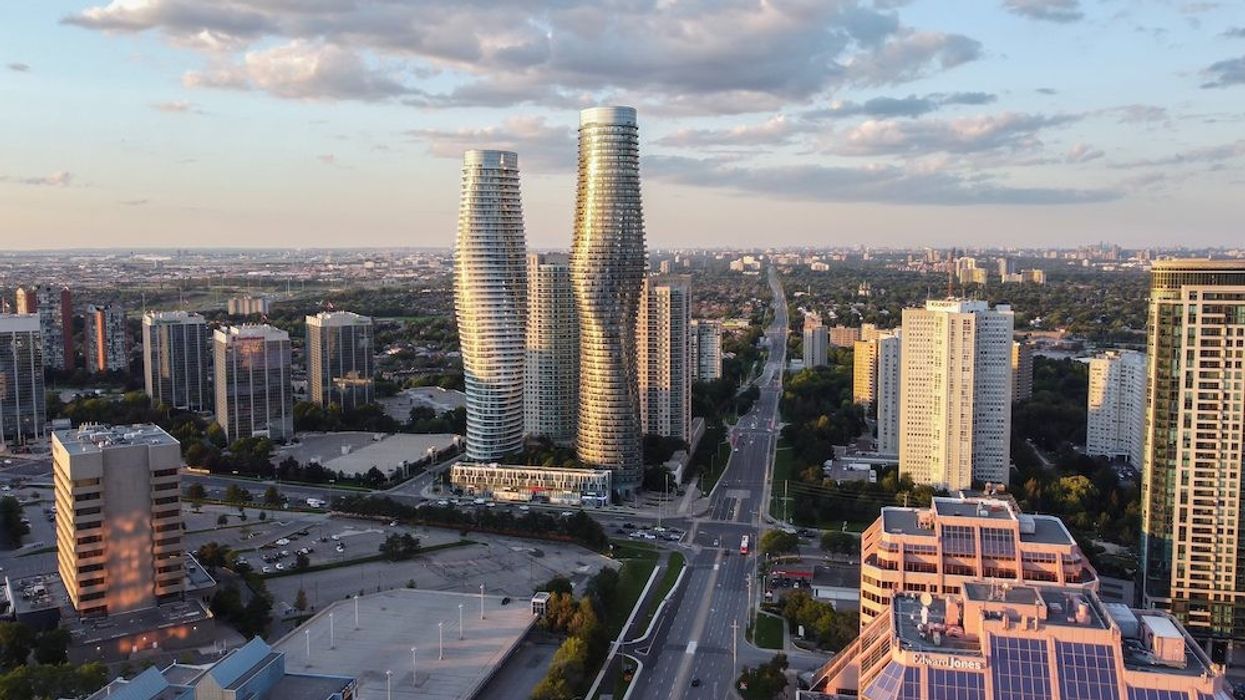Dubai isn’t just any old city; it is a place without limits, a paragon of civic ambition, a global centre of extravagance, above all, architectural extravagance. With its skyscraper opulence and built brashness, deliberately over-the-top towers and glittering shopping malls, it’s a truly 21st-century city, impossible to ignore yet unexpectedly generic. Designed to be exceptional, Dubai is a city of exceptions.
Alas, when everything is exceptional, nothing is exceptional.
If that sounds familiar, it should. Canada’s very own Dubai, the country’s sixth-largest city, sits next door to Toronto. Though it has been the object of many a sneer, there’s something happening here that can’t be denied. Love it or hate it, this is a city unchained from the usual restraints of more conventional metropolises, everything from zoning and height regulations to traditional neighbourhoods, heritage preservation and, above all, context.
We refer, of course, to Mississauga.
Like Dubai, Mississauga is a city where anything goes. No, it can’t boast the world’s tallest building -- the Burj Dubai -- or the planet’s only palm-shaped residential development. But it does have the world’s sexiest condo towers, best known by their nickname, the Marilyn Monroes (officially known as the Absolute Towers). It also has a fantasy city hall that would make any self-respecting Emirati green with envy. And let’s not forget Square One; it’s a little out of date and not much to look at, but it certainly expresses the unabashed dedication to shopping that makes Dubai what it is.
READ: Toronto Isn’t Just a City With Low Self Esteem
Importantly, Mississauga, unlike Dubai, is not a city-state. No hereditary sheikh rules here; instead until recently Mississauga had Her Worship Hazel McCallion who presided over Mississauga with unquestioned authority for almost four decades.
But let’s be honest: there are enormous differences between Mississauga and Dubai. Most obvious is the lack of public transit -- in Mississauga that is, not Dubai. Indeed, like the biggest urban agglomerations in China, the City of Gold is intent on ringing the region with transit. In addition to LRTs, three metro lines and 200 bus routes, there’s even a monorail. In comparison, Mississauga remains stuck in the last century, the dark age of transport, still years away from completing its first light rail line.
On the other hand, Mississauga’s commitment to the automobile equals anything the Emiratis can muster. The network of highways built to serve the car is impressive in both places, so when it comes to driving fast, residents of the two cities are well served. In this regard, the lack of pedestrians is helpful in both locations. No wonder congestion is a shared plague.
The more one thinks about it, differences between Mississauga and Dubai are clearly outweighed by the similarities. The two cities are young; their journey to urbanity didn’t begin in earnest until the 1970s. Fuelled by globalized capital, a powerful development industry and the international marketing juggernaut, both cities are in a race not just to join the future but also to define it.
Unlike traditional slow cities grounded in history, vested interests, not to mention nostalgia, everything in Dubai and Mississauga wants to be shiny, fast and fluid. Unconcerned with history, both exist in an ever-changing condition of extraordinary ordinariness.
While cities of the past are awash in what we politely call “background buildings” -- utilitarian buildings intended to serve the day-to-day needs of residents -- they are also useful as a backdrop to the city’s architectural and cultural landmarks. Dubai and Mississauga have reversed that dynamic. Where the streets of, say, Toronto, are lined with fabric buildings, there’s little room in the hyper-financialized cities of the future for economic laggards. Even now they must be uber-performers, not merely profitable but lavishly so. This means they must also be impossible to ignore. They must grab our attention and not let go. They must make us gasp in awe, entertain and engage us. They must be the tallest, the biggest, the most expensive, the most exclusive, the most exceptional…
The effects on so-called serious architecture remain to be seen, but certainly the ever-greater pressure of performance anxiety has driven practitioners to new heights of novelty, if not folly.
The most significant difference between Dubai and Mississauga lies in the latter’s reluctance to embrace fully the civic narcissism that has made the former an international icon. But Mississauga is closing the gap: projects such as M City, Exchange District and Absolute condos would be right at home in Dubai.
Mississauga’s “multiplication by subdivision” years now feel passé. Pioneers have given way to settlers. The defining building form here -- and Dubai -- is the tower. And not just the tower, but the tower liberated from the orthogonal angst of modernist architecture. While a city like Toronto must destroy itself to accommodate growth, Mississauga and Dubai have little worth keeping.
“We are shedding our suburban image,” Mississauga Mayor Bonnie Crombie rightly noted in a speech made to the Mississauga Board of Trade in 2020.
Even if things aren’t getting better, they’re definitely getting bigger.





















